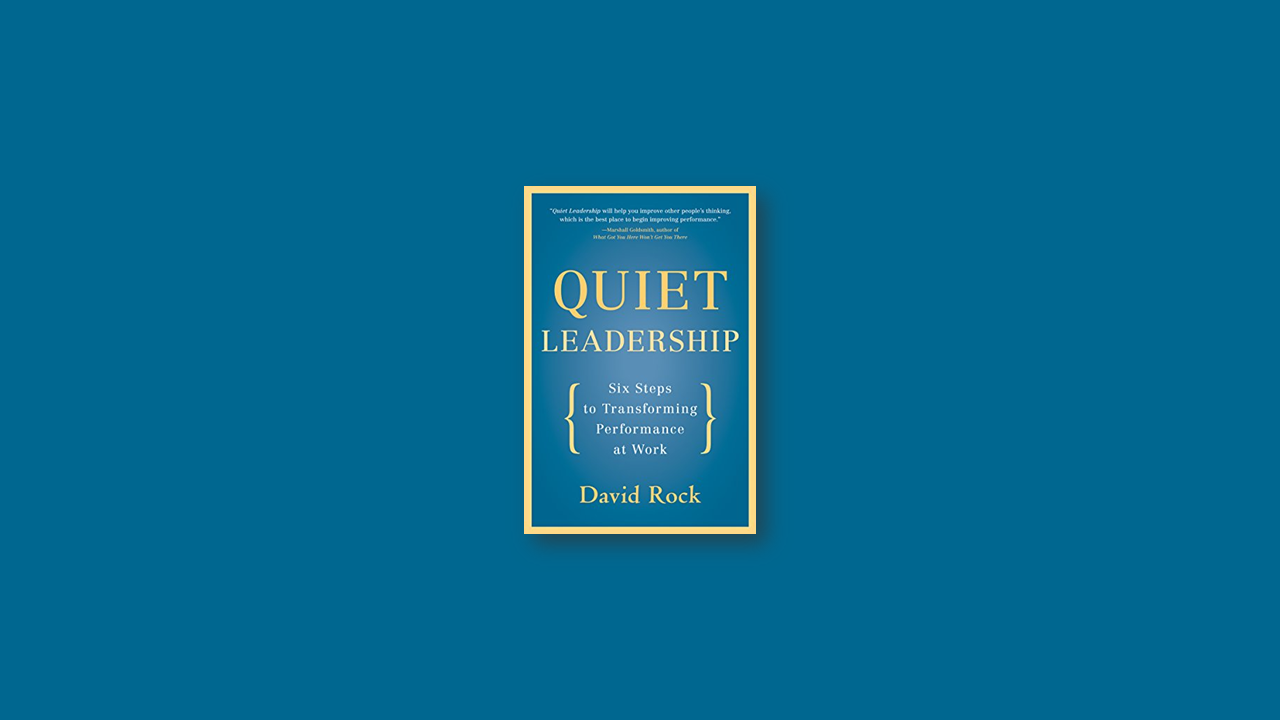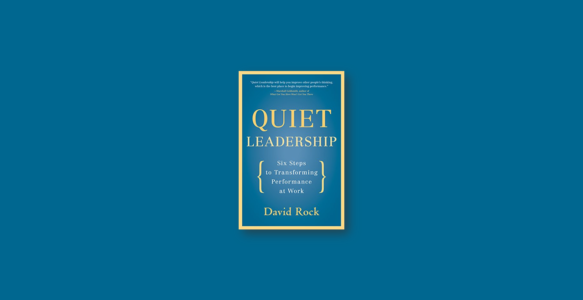Quiet Leadership provides a brain-based approach that will help busy leaders, executives, and managers improve their own and their colleagues’ performance. David Rock offers a practical, six-step guide to making permanent workplace performance change by unleashing higher productivity, new levels of morale, and greater job satisfaction.
#1 Think About Thinking
The first step to being a Quiet Leader is to think about people’s thinking. In other words, to become passionate about improving not what people are thinking about, but the way they think.
Ideas are like children, there are none so wonderful as your own CHINESE FORTUNE COOKIE (2005)
thinking. Quiet Leaders let other people do all the thinking, then gently keep the conversation focused on solutions. They stretch people more than people stretch themselves, while providing extensive positive feedback. And they know that taking time to establish good process in any situation is a key to having the most useful conversations. Having all these ideas in mind is the first step to being able to improve people’s thinking without telling them what to do. It’s the first step to transforming performance at work.
#2 Listen For Potential
Quiet Leaders listen for potential. They understand that if we’re not measuring and monitoring how people are growing, we can easily fall into the trap of focusing on their problems. They know that the first step to seeing positive change in others is to expect it.
summary, we all have the ability to listen to other people as their potential. However, it’s also easy to get lost in the details, misled by our filters and agendas, or sidetracked by our hot spots. It’s a matter of understanding these frames and being aware of where you are coming from when you are listening to others. Once we become aware of what is clouding our natural clarity, we are on the way to listening to people in a whole new way.
#3 Speak With Intent
Finding colleagues who, like lovers and friends, are inspiring rather than boring or dominating is increasingly a priority. THEODORE ZELDIN (2002)
Being succinct requires you to think, to decide quickly on the essence of what you want to say, and say it in as few words as possible, focusing on using visual words. By cutting to the heart of the issue, you keep people’s attention and interest. This allows people to make their own mental models that correlate to the ideas you are trying to share. When we’re trying to transform performance, given that we know this will only happen if people have insights for themselves, giving people the space to create their own mental maps of our ideas is an essential first step to change.
The challenge of using simple language is you have to know what you are talking about.
Quiet Leaders speak with intent. They are succinct, specific, and generous a lot of the time, especially when they are trying to transform performance. Speaking this way provides a foundation for real change to occur.
#4 Dance Toward Insight
To learn is to change how you think. MICHAEL MERZENICH (1992)
The Dance of Insight is a framework for having conversations that help people think better, without telling them what to do. The Dance of Insight is central to being a Quiet Leader. It’s about getting permission before getting personal, then making sure you’re both on the same page before asking a question, then asking questions that create new maps in people’s minds.
As you quietly facilitate this dance, you’ll see people’s faces changing as they move from the awareness of a dilemma, to reflecting, to having an illumination, and then being ready to take action. Having these dance steps in your repertoire as a leader will make a tremendous difference to the quality of your people’s thinking, and therefore their performance.
#5 Create New Thinking
What we think, we become. GAUTAMA BUDDHA (563 BC TO 483 BC)
CREATE stands for 1) Current Reality 2) Explore Alternatives 3) Tap their Energy.
The first element of the CREATE model is to explore the Current Reality for someone, the reality of their thinking itself. At this point, people become aware of their dilemma, they reflect, and then, if you ask the right questions, have an insight of some kind.
We then move to the second element, Explore Alternatives. By this point people have had an insight and want to do something with the insight, but are not yet sure what. So we throw around different ideas. We might make gentle suggestions or give clues to other perspectives or approaches here. This stage helps ensure people don’t take the easiest path when they have an insight, but rather that they find the best option for moving an insight into action.
The third element of the CREATE model is Tap their Energy. People are now in the motivation state of the Four Faces of Insight: They are energized about doing something, but we know this energy won’t last. So we help people take tangible actions to move their insights from delicate new connections to something more likely to become a part of their thinking. Or in plain English, we’re helping people turn their insights into habits.
#6 Follow Up
Cells that fire together, wire together. CARLA SCHATZ (1992)
The final big idea in this book is the FEELING model. FEELING stands for Facts, Emotions, Encouragement, Learning, Implications, and New Goals. The FEELING model is best used when following up your team commitments.
- The first thing to do is simply to get the facts. Try to remain emotionally neutral in this phase and just get the information about what was done compared to what had been planned.
- Once you’ve got the facts about how far someone went with an action, the next step is to see how they feel about what they achieved.
- Given that people are being stretched here, it’s important to encourage them generously, to help make the experience a positive one.
- We want to help identify any new wiring people are developing and new habits in the early stages of formation. And not just identify new wiring, but name it, understand it, hold it in our hands, see it from many angles. We want to give it lots of attention.
- Once you have the facts, checked in on emotions, encouraged them, and identified what the big learning was, next you want to explore the implications of what someone has learned.
The final part to the FEELING model is to identify the next goal to focus on. Help them recognize and therefore further embed the habits they are developing. By doing this in a positive and supportive way, we give people the encouragement they need to turn their delicate new circuits into full-blown hard wiring. It’s not a difficult process, it takes just a few minutes—but it can make a world of difference.


